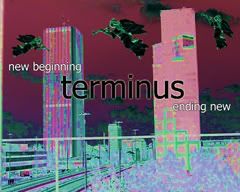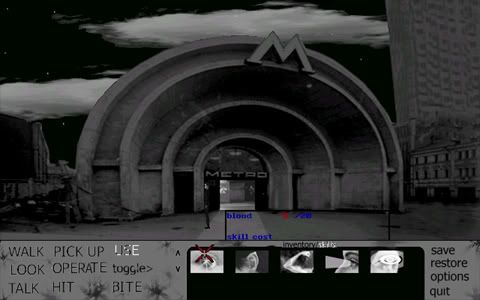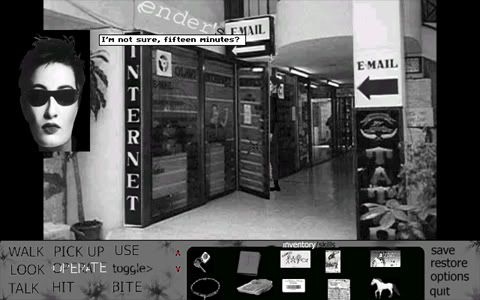Almost all independently designed adventure games have an interface that is based either on Sierra, Lucasarts or a verb-coin. The way of conducting dialogues is also extremely similar in all titles: you select a sentence and a character says it.
The reason for these types to be so widespread lies probably in the fact that the most famous games used such GUIs.
I also copied a typical Lucasarts interface without giving it any thought.
THIS IS BORING!!!
Why don't we give some thoughts to the question of interface now?
Remember that the interface, as a means through which the player operates in the world of a game, must have a big impact on the player's reaction to your product.
For me, the success of Bestowers of Eternity lays mostly in the innovative use of the notepad. Masterful stroke. Genius.
In this thread, I would like to tell you about some of my favourite adventure games that have GUIs different from the most popular, yet they work very neat.
Most of them are quite old and are made for Commodore 64 -- the reason for their interfaces being so different is probably that the famous best-selling games weren't there to copy them. I encourage you to download an emulator and try them out, most of them can be found on www.c64games.de
I really think that we can use some ideas or get inspired by these titles to try new, alternative interfaces.
These oldies, though almost forgotten, are much more innovative than newcomers!
PART 1: Neuromancer

This, ladies and gentlemen, is Neuromancer on C64. The game has a PC version, but it's graphics is greatly inferior to the C64's one.
The most fascinating thing about Neuromancer is that the game takes place on 3 levels: one is the real world, in which you walk, talk with people, buy and sell hardware and software, and even at some moment take a space trip.
Second level is the world of databases, message bulletins, media coverages, banking systems etc. in the "internet" to which you connect with your computer. This part is text-based. You may send messages, download and upload software, try to access higher levels of police or banking sites, use passowrd decryptors and even play in a chess tournament.
Third level is the Cyberspace, the virtual representation of the Net, data clusters, black ice and AIs that protect the most important data clusters.
The controls are with joystick or keyboard. The upper row of icons is: 1) toggle the info displayed on the bar above (money, time, energy); 2) access inventory (and do stuff with it), 3) access Public Announce System (banking, news etc.), 4) talk to characters that are in the room.
The lower row: 1) Use Skills (great feature, used mostly for fighting with AI, but also in the real world - like playing music; you upgrade those with special chips), 2) Walk - you control the protagonist to move between rooms, 3) ?don't remember??, 4) load/save/exit etc.
You should really try how smooth the gameplay is.
And this is the best, most involving cyberpunk/hacking game ever made. For a computer of 64 kb. Year? 1988. Thank you. What happened since then? Bloodnet and Uplink. Thank you.
PART 2: Frederic Pohl's Gateway

For people, who (like me) are too lazy to really play all Interactive Fiction games, I propose 2 Gateway games and Time Quest, all of them by Legend, all of them at Underdogs.
The most interesting thing about these games is that they appeared in a period of technological advance in terms of graphics and music before IF became obsolete.
They have animated graphics, sound and cutscenes, yet you control the protagonist with text parser.
A perfect combination if you ask me, and the way that I will definitely follow after I finish Donna.
The player doesn't need to stretch his/her imagination too far, because of attractive graphics and music. The gameplay and puzzles are immensly enriched! You cannot just "use" things, you have to think what to do with them! You type yourself what you want to say! Unforgetable experience, feeling of freedom (because many things aren't shown in graphics, the designers could allow a lot more actions that in P&C), very satisfactory - especially if you finish those games by yourself.
You also have a compass to move, list of basic commands for the lazy, and a map.
Check Legend's games for PC at http://old.the-underdogs.org/Legend.htm
PART 3: Captain SniffPants in Mines of Doom

LOL, okay, everyone knows what game this is. Dowload it for free from my site (along with free porn) ;-)
I think that the lack of a separate GUI vastly increased the player's immersion in Grim Fandango. A set of commands or icons always, in a way, prevents us from believing that what we see is a real world.
Notice that the only time that the convention was shattered was the save/load/exit gui. The fact that you could walk with keys, not click, somehow made us more keen to believe that it is US who walk these streets, not some kind of a remotely steered puppet. Even handling inventory didn't shatter the illusion, you didn't have a separate screen with items, Manny took them out of his coat one by one.
I believe that - apart from the story - this was a very important factor that decided about the fame of GF.
Nomad Soul boasts a similar approach, although the convention is shattered more often (inventory gui, stats screen, etc.)

If you like this thread, I will post more games with alternative interfaces. Learning from them could really enrich the genre, by copying or - even better - having more courage to invent own interfaces.
Also, please post your own examples that could teach us something new.
The reason for these types to be so widespread lies probably in the fact that the most famous games used such GUIs.
I also copied a typical Lucasarts interface without giving it any thought.
THIS IS BORING!!!
Why don't we give some thoughts to the question of interface now?
Remember that the interface, as a means through which the player operates in the world of a game, must have a big impact on the player's reaction to your product.
For me, the success of Bestowers of Eternity lays mostly in the innovative use of the notepad. Masterful stroke. Genius.
In this thread, I would like to tell you about some of my favourite adventure games that have GUIs different from the most popular, yet they work very neat.
Most of them are quite old and are made for Commodore 64 -- the reason for their interfaces being so different is probably that the famous best-selling games weren't there to copy them. I encourage you to download an emulator and try them out, most of them can be found on www.c64games.de
I really think that we can use some ideas or get inspired by these titles to try new, alternative interfaces.
These oldies, though almost forgotten, are much more innovative than newcomers!
PART 1: Neuromancer

This, ladies and gentlemen, is Neuromancer on C64. The game has a PC version, but it's graphics is greatly inferior to the C64's one.
The most fascinating thing about Neuromancer is that the game takes place on 3 levels: one is the real world, in which you walk, talk with people, buy and sell hardware and software, and even at some moment take a space trip.
Second level is the world of databases, message bulletins, media coverages, banking systems etc. in the "internet" to which you connect with your computer. This part is text-based. You may send messages, download and upload software, try to access higher levels of police or banking sites, use passowrd decryptors and even play in a chess tournament.
Third level is the Cyberspace, the virtual representation of the Net, data clusters, black ice and AIs that protect the most important data clusters.
The controls are with joystick or keyboard. The upper row of icons is: 1) toggle the info displayed on the bar above (money, time, energy); 2) access inventory (and do stuff with it), 3) access Public Announce System (banking, news etc.), 4) talk to characters that are in the room.
The lower row: 1) Use Skills (great feature, used mostly for fighting with AI, but also in the real world - like playing music; you upgrade those with special chips), 2) Walk - you control the protagonist to move between rooms, 3) ?don't remember??, 4) load/save/exit etc.
You should really try how smooth the gameplay is.
And this is the best, most involving cyberpunk/hacking game ever made. For a computer of 64 kb. Year? 1988. Thank you. What happened since then? Bloodnet and Uplink. Thank you.
PART 2: Frederic Pohl's Gateway

For people, who (like me) are too lazy to really play all Interactive Fiction games, I propose 2 Gateway games and Time Quest, all of them by Legend, all of them at Underdogs.
The most interesting thing about these games is that they appeared in a period of technological advance in terms of graphics and music before IF became obsolete.
They have animated graphics, sound and cutscenes, yet you control the protagonist with text parser.
A perfect combination if you ask me, and the way that I will definitely follow after I finish Donna.
The player doesn't need to stretch his/her imagination too far, because of attractive graphics and music. The gameplay and puzzles are immensly enriched! You cannot just "use" things, you have to think what to do with them! You type yourself what you want to say! Unforgetable experience, feeling of freedom (because many things aren't shown in graphics, the designers could allow a lot more actions that in P&C), very satisfactory - especially if you finish those games by yourself.
You also have a compass to move, list of basic commands for the lazy, and a map.
Check Legend's games for PC at http://old.the-underdogs.org/Legend.htm
PART 3: Captain SniffPants in Mines of Doom

LOL, okay, everyone knows what game this is. Dowload it for free from my site (along with free porn) ;-)
I think that the lack of a separate GUI vastly increased the player's immersion in Grim Fandango. A set of commands or icons always, in a way, prevents us from believing that what we see is a real world.
Notice that the only time that the convention was shattered was the save/load/exit gui. The fact that you could walk with keys, not click, somehow made us more keen to believe that it is US who walk these streets, not some kind of a remotely steered puppet. Even handling inventory didn't shatter the illusion, you didn't have a separate screen with items, Manny took them out of his coat one by one.
I believe that - apart from the story - this was a very important factor that decided about the fame of GF.
Nomad Soul boasts a similar approach, although the convention is shattered more often (inventory gui, stats screen, etc.)

If you like this thread, I will post more games with alternative interfaces. Learning from them could really enrich the genre, by copying or - even better - having more courage to invent own interfaces.
Also, please post your own examples that could teach us something new.


 ) think that everyone on this forum knows what is "Best Buy" or "Circuit City"?
) think that everyone on this forum knows what is "Best Buy" or "Circuit City"?



